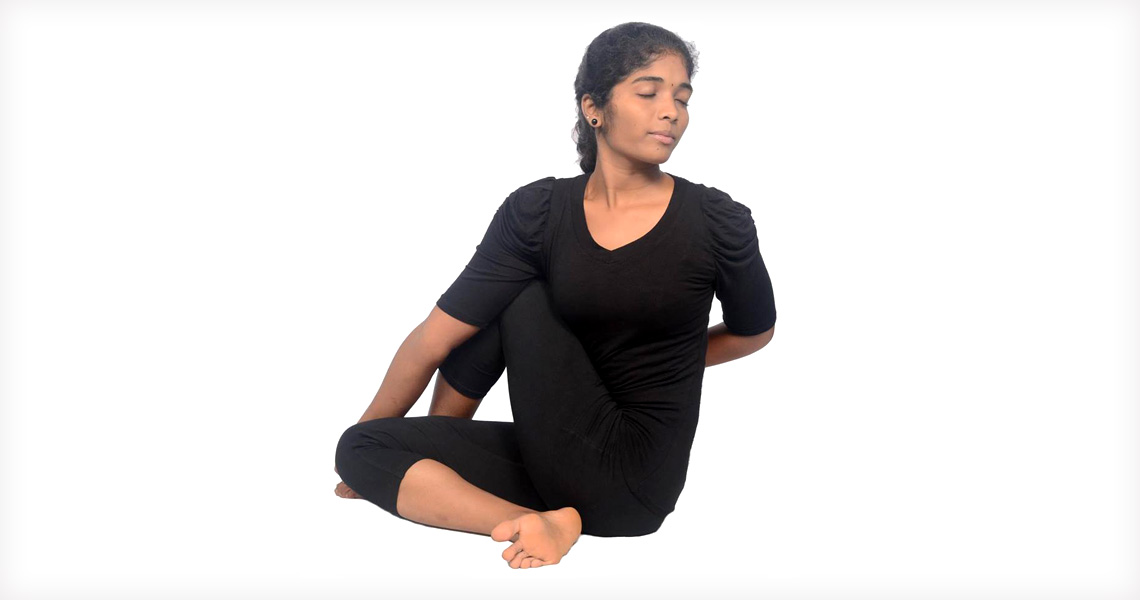Ardha Matsyendrasana (Half spinal twist)

Welcome to Ashtanga Yoga Collection Project!
At AYA, we are attempting to demystify any secrets and misgivings about Ashtanga Yoga.
The following article will try to provide comprehensive and neutral information from various subject-matter experts about Ashtanga Yoga Postures and Practices. We have called this 'Ashtanga Yoga Collection' Project. This project aims to become a ready-reckoner and a reference for yoga teachers and enthusiasts training in Ashtanga Vinyasa Yoga. Although it is not an open forum, we invite participation from Ajarya Teachers as also yoga teachers from all over the world. All your submissions will be reviewed by our panel before they are published online.
The Procedure:
- Sit with the legs stretched out in front of the body.
- Bend the right leg and place the right foot flat on the floor on the outside of the left knee.
- The toes of the right foot should face forward.
- Bend the left leg and bring the foot around to the right buttock. The outside edge of the foot should be in contact with the floor.
- Pass the left arm through the space between the chest and the right knee, and place it against the outside of the right leg.
- Hold the right foot or ankle with the left hand so that the right knee is close to the left arm pit.
- Sit up as straight as possible.
- Raise the right arm in front of the body and gaze at the finger tips.
- Slowly twist to the right, simultaneously moving the arm, trunk and head.
- Use the left arm as a lever against the right leg to twist the trunk as far as possible without using the back muscles.
- Follow the tips of the fingers of the right hand with the gaze and look over the right shoulder.
- Do not strain the back.
- Bend the right elbow and place the arm around the back of the waist.
- The back of the right hand should wrap around the left side of the waist.
- Alternatively, it can be placed as high as possible between the shoulder blades with the fingers pointing up.
- This arm position enforces the straightness of the spine.
- Reverse the movements to come out the posture and repeat on the other side.
Benefits:
- Increases the elasticity of the spine, tones the spinal nerves and improves the functioning of the spinal cord.
- Stretches the muscles on one side of the body whilst compressing the muscles on the other side.
- Relieves back pain and stiffness from between the vertebrae.
- Useful for slipped disc.
- Massages the abdominal organs and increases the digestive juices making it useful for loss of appetite and constipation.
- Useful for diabetics, with concentration on the pancreas.
- Regulates the secretion of bile and adrenaline.
- Relieves tension that may have built up in the back from forward and back bending asanas.
- Opens the chest and increases the oxygen supply to the lungs.
- Loosens the hip joints, relieving stiffness.
- Releases tension in the arms, shoulders, upper back and neck.
- Increases purification of the blood as well as the internal organs.
- Improves round shoulders.
Benefits for Women:
- Increases the circulation to the pelvic region and therefore providing fresh blood, nutrients and oxygen, improving the health of the reproductive organs as well as the urinary system.
- Useful for preventing urinary tract disorders.
- Beneficial for menstrual disorders.
Precautions and Contraindications:
- Should be avoided during pregnancy and menstruation due to the strong twist in the abdomen.
- People with Heart, abdominal or brain surgeries should not practice this asana.
- Care should be taken for those with peptic ulcer or hernia.
- Those with severe spinal problems should avoid and those with mild slipped disc can benefit but in severe cases it should be avoided.
Contributors to Ardha Matsyendrasana
- The Half Spinal Twist has been demonstrated by Ms Niharika Raval, who is a part of Yoga Archanam Project at Surendranagar, Gujarat, India, pursuing PhD in Dance.
- The Ardha Matsyendrasana Procedure has been provided by Sri Viral Raval, who is a part of Yoga Archanam Project at Surendranagar, Gujarat, India, pursuing PhD in Yoga
- The limitations and benefits of Ardha Matsyendrasana been given by Ms Niharika Raval
- The Physiology of Ardha Matsyendrasana been designed and provided by Dr E Amaravathi, a Master in Physiotherapy currently pursuing PhD in Yoga and also teaching at Ajarya Yoga Academy
- The Scientific Explanation and Clinical Significance (available only to registered Ajarya teachers) of Ardha Matsyendrasana been provided by
Dr E Amaravathi,teaching currently at Ajarya Yoga Academy
Please write to us if you wish to become a Ajarya Contributor!